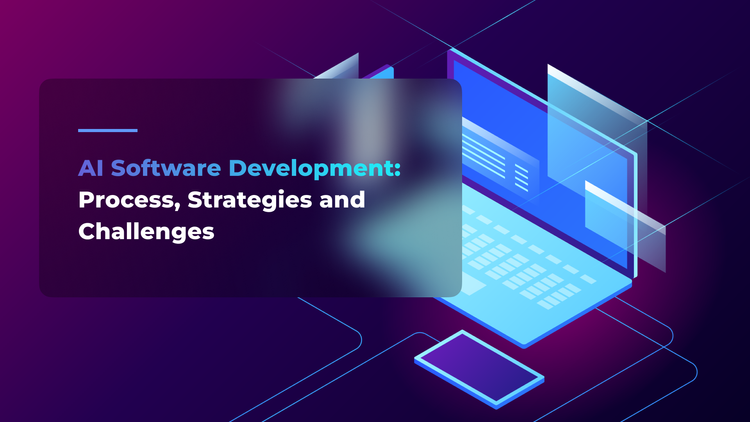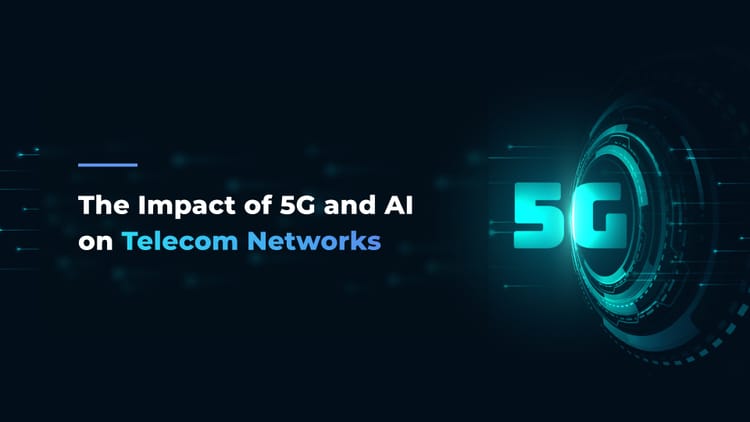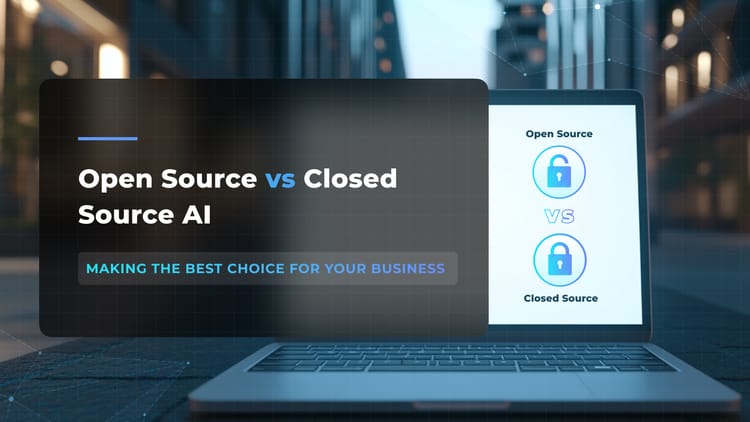Top 9 Cloud-Based AI Development Platforms: Reliable Choices for Your Business
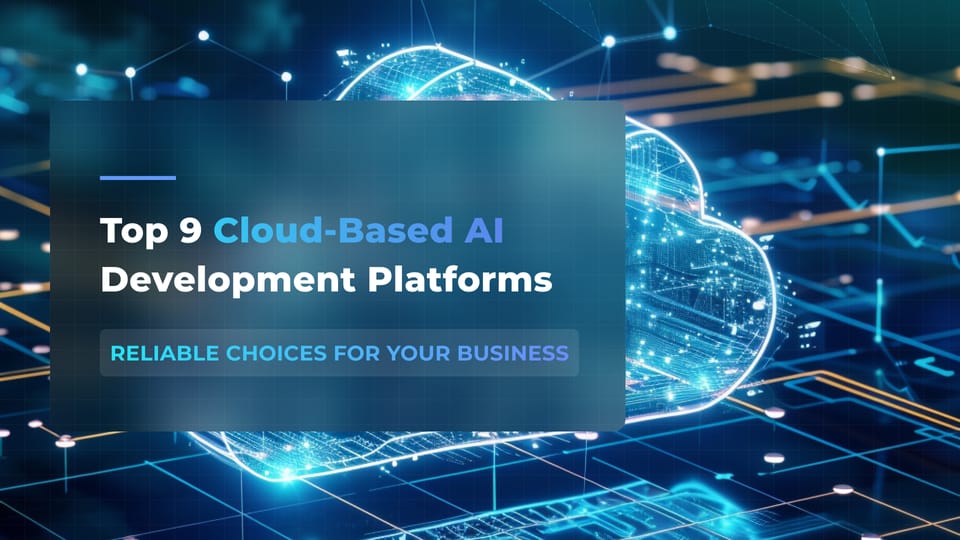
When you're building an AI-driven solution, you need three things: significant computational resources, scalable infrastructure, and robust data handling capabilities. Right now, there’s no better place to find all of that than through cloud services. That's why major cloud providers have been racing to roll out AI development tools and fully equipped platforms built on their cloud infrastructure. They knew the demand would be huge, and the data backs it up. According to Synergy Research, AI has been a major driver of increased cloud spending.
But with so many great options out there, how can you choose the right AI development platform? We at Flyaps decided to simplify this part for you. As a software developing company with over 11 years of experience and a proven track record in both cloud engineering and AI, we know a thing or two about both cloud and AI. So, we would like to share the top cloud-driven AI development platforms and their capabilities with you. Moreover, we will also highlight key factors to consider when selecting the best platform for your project.
Top AI cloud development platforms
Let’s kick things off by discussing the three leading cloud providers competing not only for cloud market dominance but also for leadership in AI: Google, Microsoft, and Amazon. Amazon holds the largest share of the global cloud market at 31%. Despite AWS’s AI revenue increasing by 17% year-on-year, Google, with its 10% share of the global cloud market (ranking third after Microsoft’s 21% in the fourth quarter of 2023), is leading in AI innovation and capabilities. Amazon, meanwhile, was praised by Omdia researchers for operational efficiency.
Later on, we will also take a look at smaller yet quite significant providers such as Alibaba or Oracle, which also play important roles in the cloud and AI sectors. But for a better picture, it’s worth starting with the innovation leader.
Vertex AI by Google
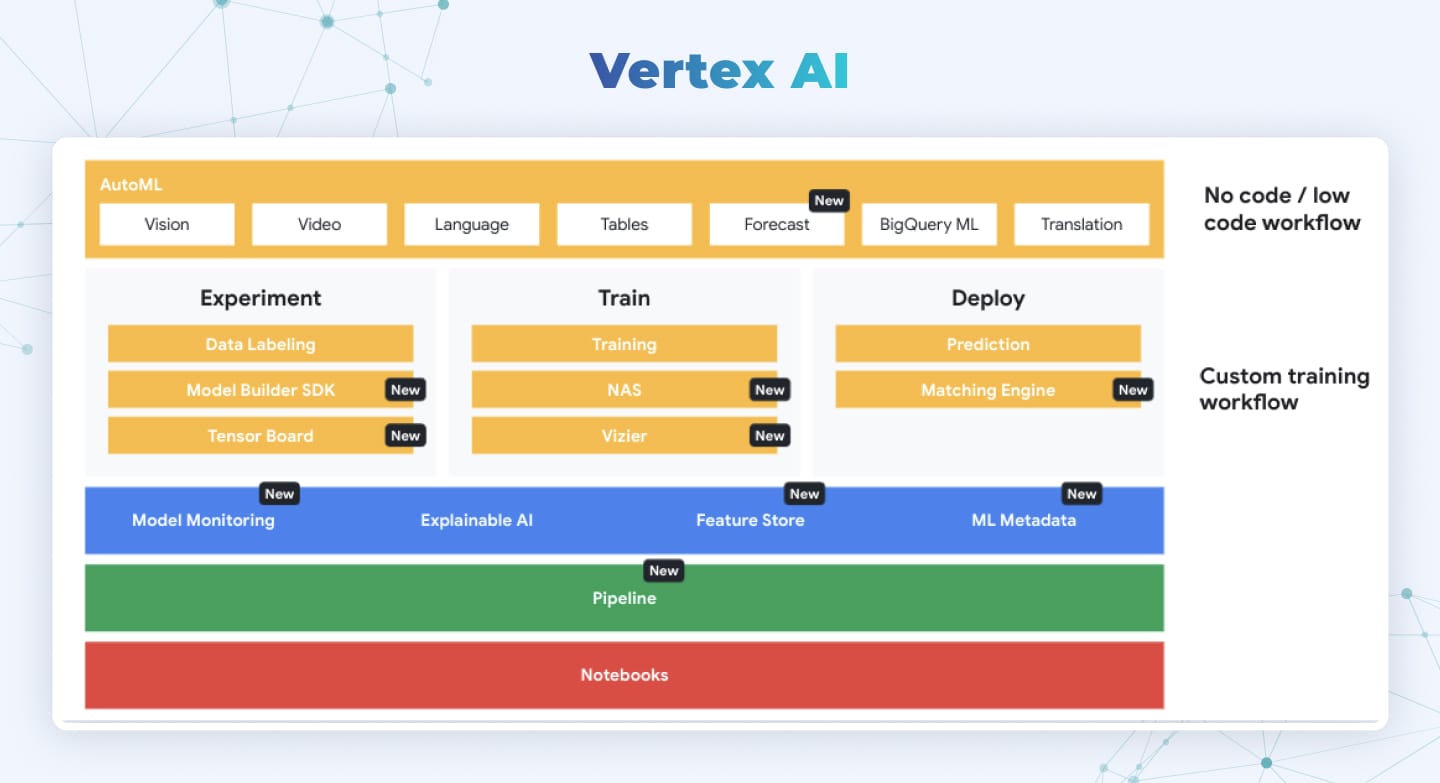
Google has a really powerful cloud infrastructure and a long history of AI investments like TensorFlow or Gemini — no wonder its Vertex AI is so popular on the market. In a nutshell, the platform is a set of tools for building and scaling ML applications on Google’s cloud infrastructure.
For visual tasks, the platform includes Vertex AI Vision, which lets you add features like object tracking, image detection, and facial recognition to your apps. Video Intelligence extends these capabilities to analyze and transcribe video content if you’re working with videos. When it comes to language processing, Translation Hub offers pre-built models to translate text into 135 languages, which is great for supporting multilingual users. Vertex AI API tool lets you integrate your trained models into applications to make predictions on new data. Vertex AI Model Registry is a hub for managing the lifecycle of your ML models. It gives you a clear overview of all your models, making it easier to organize, track, and train new versions. Lastly, Vertex AI Search (former Recommendation AI) uses ML algorithms to generate personalized and relevant recommendations based on user data.
Another plus is that Vertex can be easily integrated with other helpful Google services for AI development, such as TensorFlow.
| Vertex AI’s tools for AI development | |
| Vertex AI Vision | Useful for dealing with images. |
| Video Intelligence | Useful for dealng with video. |
| Translation Hub | Models for translation in 135 languages. |
| Vertex AI API | Useful for predictions. |
| Vertex AI Model Registry | Useful for managing ML models. |
| Vertex AI Search | Useful for personalized recommendations. |
Azure AI Platform

According to Microsoft, more than 65% of the Fortune 500 are users of one of Azure’s services — Azure OpenAI service. The very first thing that makes Microsoft’s AI services so popular is the same with Google — a huge ecosystem of tools for various purposes. Whether you're working on machine learning, natural language processing, or computer vision, Azure has got you covered with a wide range of pre-built tools, APIs, and models.
What makes Azure stand out is its unique solutions like, for example, anomaly detector — a customizable solution for spotting anomalies in time series data without needing deep ML knowledge. The previously mentioned Azure OpenAI Service gives access to powerful models like GPT-3.5. Azure AI Vision and Custom Vision handle image and video processing with ease and even train custom models for specific tasks. Azure AI Speech converts speech to text and vice versa, builds custom voice models, and more – perfect for enhancing user interactions.
Also, Microsoft offers Azure AI Machine Learning — a comprehensive platform for building, training, and deploying ML models at scale, perfect for collaboration between data scientists and developers. Azure Bot Service is designed for creating and managing intelligent chatbots that can interact on multiple platforms.
Furthermore, Azure AI services like Video Indexer and Document Intelligence are great for extracting valuable insights from video, audio, and document content. This means you can turn your raw data into actionable information, helping you make better business decisions.
| Azure AI Platform’s tools for AI development | |
| Azure OpenAI | Gives access to OpenAI's models. |
| Anomaly detector | Useful for spotting anomalies. |
| Azure AI Vision and Custom Vision | Useful for dealing with images and video. |
| Azure AI Speech | Converts speech to text. |
| Azure AI Machine Learning | Useful for building, training, and deploying ML models. |
| Azure Bot Service | Useful for managing chatbots. |
| Video Indexer | Useful for extracting information from visual content. |
| Document Intelligence | Useful for extracting information from documents. |
Learn how to ensure your AI project succeeds – read our comprehensive guide “AI Project Management: Strategies for Success and Overcoming High Failure Rates.”
AI can do more for your business—let’s find the best way to make it work for you. Check out our expertise and let’s discuss your next AI project.
See our AI servicesAmazon SageMaker

Amazon SageMaker's tools for building, training, and deploying ML models are just as impressive as those offered by Google and Azure. The development environment includes Jupyter Notebooks, making data exploration and preprocessing easy and enabling quick collaboration. SageMaker Autopilot takes care of automated machine learning, giving you full control and visibility over model creation, while the Ground Truth feature helps create accurate labeled datasets using human labelers and pre-built workflows.
For model training, SageMaker provides tools like SageMaker Experiments to organize, track, and evaluate different iterations by automatically capturing configurations, parameters, and results. SageMaker Debugger helps analyze, debug, and fix issues during training by capturing real-time metrics and providing alerts for common problems. Managed Spot Training helps cut costs by using spare AWS compute capacity.
When it comes to deploying models, SageMaker offers a one-click deployment feature that simplifies the process for both real-time and batch predictions. Model Monitor detects and mitigates concept drift by continuously monitoring deployed models and providing alerts to identify prediction issues. Augmented AI allows human reviewers to step in for low-confidence predictions to ensure accuracy, and Elastic Inference reduces inference costs by providing scalable GPU resources. SageMaker also integrates with Kubernetes, making the deployment, scaling, and management of machine learning models in containerized environments easier.
| Amazon SageMaker's tools for AI development | |
| SageMaker Autopilot | Useful for automated machine learning. |
| Ground Truth | Creates labeled datasets. |
| SageMaker Experiments | Useful for controlling model training iterations. |
| SageMaker Debugger | Useful for fixing issues during training. |
| Managed Spot Training | Useful for spare AWS compute capacity. |
| Model Monitor | Useful for monitoring deployed models. |
| Augmented AI | Useful for checking accuracy. |
| Elastic Inference | Provides scalable GPU resources. |
Now, let’s talk about some other providers that aren't in the top three but still hold a significant market share in both cloud and AI.
Salesforce Einstein AI
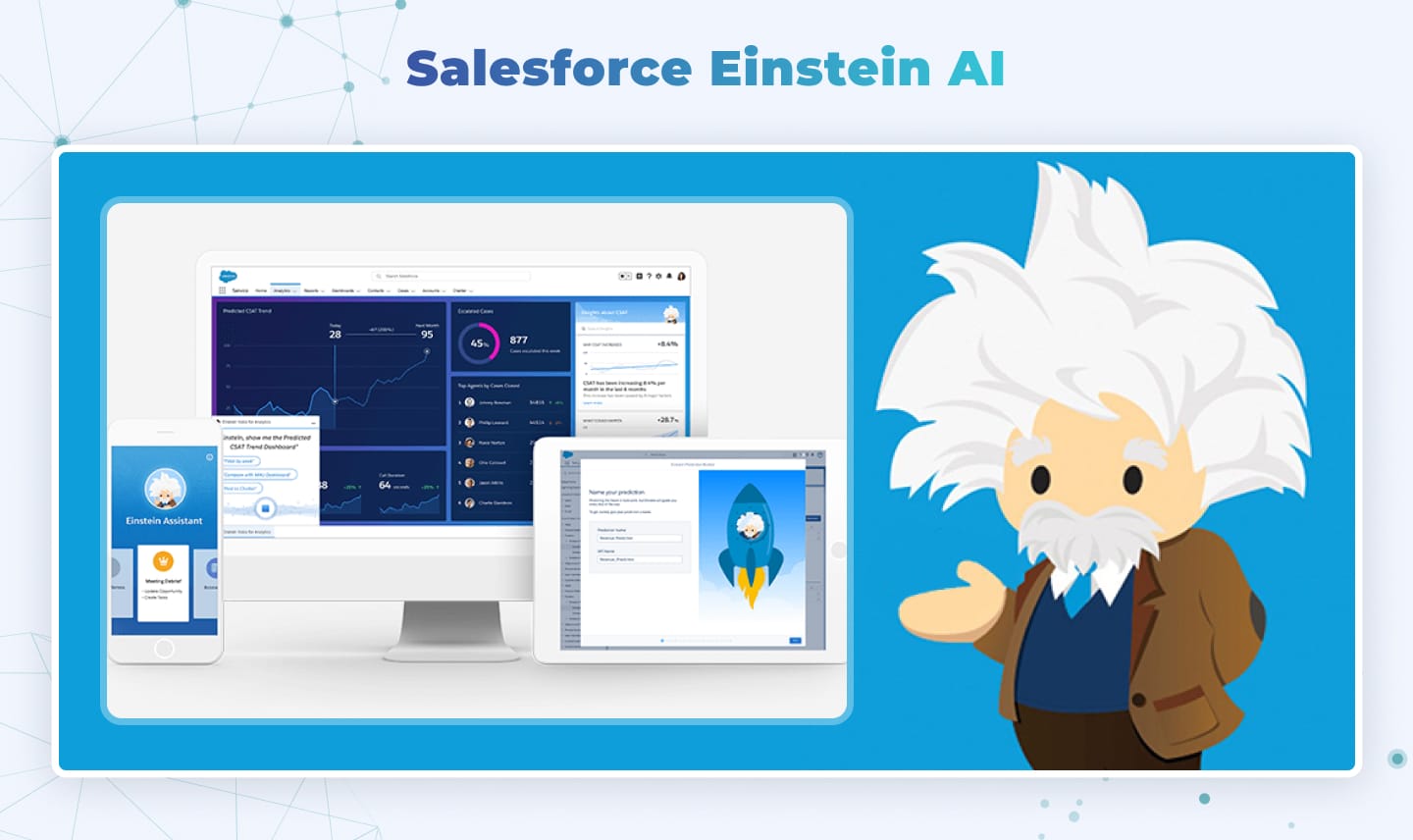
Though it’s more known as a CRM software provider, Salesforce snagged the 5th spot in the global cloud market during the fourth quarter in 2023, capturing a 3% share. Einstein AI is the first generative AI made for CRMs, which is currently integrated into various Salesforce products like Marketing Cloud, Sales Cloud, Service Cloud, and Commerce Cloud. By 2023, it was delivering over 200 billion predictions daily across these apps. Moreover, Einstein AI is data-ready, so you don’t need to prepare data or manage models. If your data is in Salesforce CRM, Einstein can give you useful insights and predictive recommendations on the spot, helping your team understand customers better, create relevant content at scale and deliver personalized experiences on any channel.
Data is the core of any AI project. Want to speed up your data pipeline setup? Check our article “How to Build a Data Pipeline Fast (for AI and LLM Projects): Comparing Top Three Choices.”
Einstein is also modeling-ready, meaning you can use its automated machine learning for specific needs without worrying about extra model management. Lastly, it's production-ready, so you can easily implement its AI capabilities in sales, marketing, service, and IT functions.
Oracle Cloud Infrastructure (OCI)
One of the flagship services within OCI is the Oracle AI Platform Cloud Service. This fully managed environment is great for building, training, and deploying ML models. It simplifies the entire process with features like Automated Machine Learning (AutoML), integrated Jupyter Notebooks for interactive coding, and robust tools for model management, including versioning, deployment, and monitoring.
OCI Data Science is a collaborative platform for data scientists to build, train, and deploy ML models. This service provides a shared workspace for teams to collaborate on projects, a library of pre-built algorithms, and scalable compute resources to handle large datasets.
For model deployment, Oracle Functions and Oracle Kubernetes Engine (OKE) enable seamless deployment of ML models as serverless functions or containerized applications. Deployed models should be monitored and managed, and for these purposes, we have Oracle Cloud Infrastructure Monitoring. The tool provides real-time metrics and alerts to track the performance and health of deployed models. When there’s a need for continuous integration and deployment, OCI DevOps offers CI/CD tools for automating the deployment and updating of ML models.
Security and compliance are ensured with robust data encryption and fine-grained access control policies, critical for industries like healthcare to comply with regulations like HIPAA.
| Oracle’s tools for AI development | |
| Oracle AI Platform Cloud Service | Useful for building, training, and deploying ML models. |
| OCI Data Science | A collaborative platform for data scientists. |
| Oracle Functions and Oracle Kubernetes Engine (OKE) | Useful for deployment models as serverless functions or containerized applications. |
| Oracle Cloud Infrastructure Monitoring | Useful for monitoring and managing deployed models. |
| OCI DevOps | Useful for automating the deployment. |
Overall, that’s just a small part of Oracle’s tools for AI development, but Oracle has done a good job of covering users’ needs at all stages of AI development.
Ready to develop an AI SaaS? Read our detailed guide “How to Create an AI SaaS: Your Guide to Strategize, Develop, and Successfully Launch a Product.”
Alibaba Cloud AI
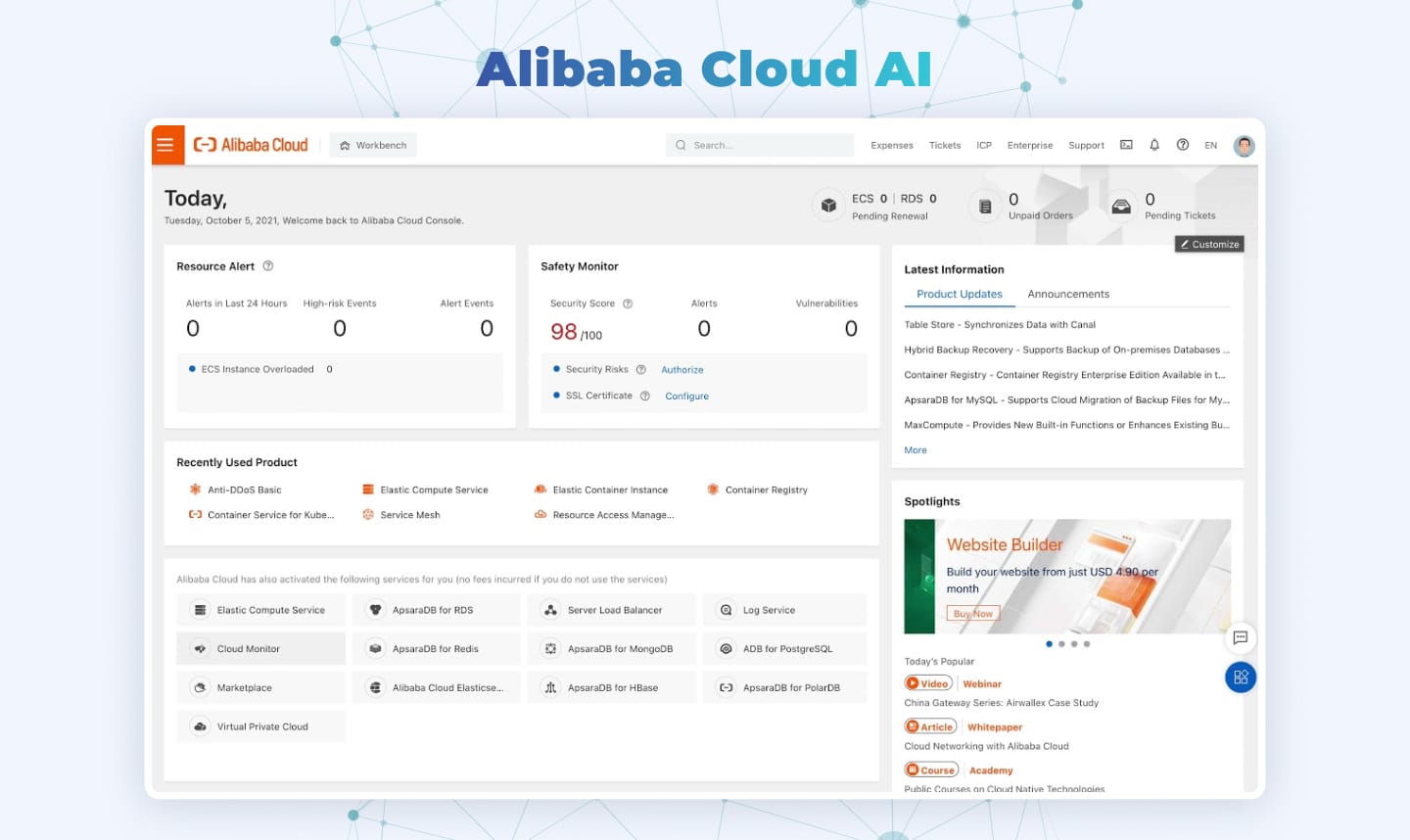
Alibaba Cloud AI is an extensive suite of AI-powered services offered by Alibaba Cloud, one of the largest cloud computing providers globally and a leading provider in Asia.
First up, Alibaba Cloud AI offers PAI-iTAG, a data labeling service. It handles different data types like images, text, video, and audio. You can use predefined labeling templates or customize your own. Plus, PAI-iTAG offers managed data labeling services if you want to outsource the work.
For developing models, there’s PAI-Designer and PAI-DSW. PAI-Designer supports CPUs and GPUs, allowing you to deploy complex models with just a few clicks and scale them as needed. It also has a solid operations and monitoring system.
When it's time to train your models, PAI-DLC is your go-to. It’s a one-stop platform for cloud-native deep learning and training. It is compatible with both predefined and custom algorithm frameworks.
Deploying models is easier with PAI-EAS and PAI-Blade. PAI-EAS supports various hardware, ensuring high throughput and low latency. It’s great for deploying large-scale models and offers real-time elastic scaling. PAI-Blade helps optimize inference performance, making sure your models run smoothly and efficiently.
Alibaba’s Machine Learning Platform for AI can help you manage your data assets throughout their lifecycle. It handles models, datasets, images, and output data, allowing you to share assets, analyze training results, and troubleshoot issues, improving performance and saving costs along the way.
In a nutshell, AI-powered services from Alibaba Cloud cover everything from machine learning to NLP and computer vision.
| Alibaba’s tools for AI development | |
| PAI-iTAG | Useful for data labeling for images, text, video, audio. |
| PAI-Designer and PAI-DSW | Useful for model development with CPUs/GPU. |
| PAI-DLC | Useful for cloud-native deep learning and training. |
| PAI-EAS | Useful for model deployment with high throughput and low latency. |
| PAI-Blade | Optimizes inference performance. |
| Machine Learning Platform | Manages data assets lifecycle; handles models, datasets, images, output data. |
Huawei Cloud AI

Huawei calls its Cloud AI a full-stack, all-scenario AI solution. By full-stack they mean the platform improves efficiency across the entire AI tech stack, right from development and to deployment. It is also flexible enough to work in all sorts of environments, like public and private clouds, edge computing, and even IoT devices.
A significant feature of HUAWEI Cloud is its powerful computing capabilities. For example, high-performance computing services, like H6 ECSs, offer substantial AI inference power. For more demanding tasks, there are services providing up to 512 TFLOPS of computing power, and for intensive training scenarios, bare-metal VMs offer up to 2 PFLOPS.
On the software side, Huawei provides CANN (Compute Architecture for Neural Networks), an operator library that optimizes performance and development. Additionally, MindSpore is their AI framework supporting all major machine learning frameworks like integration with TensorFlow, PyTorch, and Keras, aimed at making AI development more efficient and seamless.
Another notable tool is ModelArts, an all-in-one platform for AI developers. It handles data preprocessing, training, model generation, optimization, and deployment. ModelArts streamlines the entire AI development process, making it faster and less cumbersome.
For visual intelligence, there's Huawei HiLens, which includes an AI-capable camera and a cloud platform for real-time image processing tasks. It is ideal for applications like face detection and other visual AI projects.
| Huawei’s tools for AI development | |
| H6 ECSs | Useful for AI inference. |
| VMs | Provides up to 2 PFLOPS computing power for intensive training scenarios. |
| CANN | Operator library for optimizing performance and development in neural networks. |
| ModelArts | Handles data preprocessing, training, model generation, optimization, and deployment. |
| Huawei HiLens | Useful for real-time image processing tasks. |
Overall, Huawei Cloud AI is built to be flexible and scalable. It can handle big AI projects thanks to its powerful computing resources and optimized frameworks. And tools like ModelArts and HiLens make AI development quicker and more straightforward, whether you're working with massive data sets or need real-time processing.
Nutanix Xi Frame
Nutanix Xi Frame is a key service by Nutanix Cloud Infrastructure (NCI). It delivers virtual desktops and applications straight from the cloud, making workflows more flexible and ensuring you can keep your AI projects rolling no matter where you are. It also enables the testing of AI applications on various virtual desktop configurations.
Nutanix 3060-G6 All-Flash Appliance is hardware that is packed with Intel Skylake processors and all-flash storage. It can handle massive amounts of data and complex AI computations, which is perfect for running AI models that need a lot of processing power and storage.
NVIDIA DGX-1 is a tool loaded with eight Tesla V100 GPUs, making it incredibly fast and capable of handling the most demanding deep learning tasks. If you’re training complex AI models, the DGX-1 cuts down the time it takes and boosts accuracy thanks to its GPU power.
Nutanix Files is a tool for managing all the unstructured data like logs, backups, and training datasets. It’s flexible, scalable, and fully integrated, meaning you can manage everything from one place. Plus, it supports high availability and disaster recovery, so your data is always safe and accessible.
Finally, NVIDIA GPU Cloud (NGC) offers a library of GPU-accelerated containers for AI and HPC applications, making it easier to get started with AI projects.
| Nutanix’s tools for AI development | |
| Nutanix 3060-G6 All-Flash Appliance | A hardware that handles massive data and complex AI computations. |
| NVIDIA DGX-1 | Speeds up and enhances accuracy for deep learning tasks. |
| Nutanix Files | Manages unstructured data (logs, backups, datasets). |
| NVIDIA GPU Cloud (NGC) | A library of GPU-accelerated containers for AI and HPC applications. |
IBM WatsonX
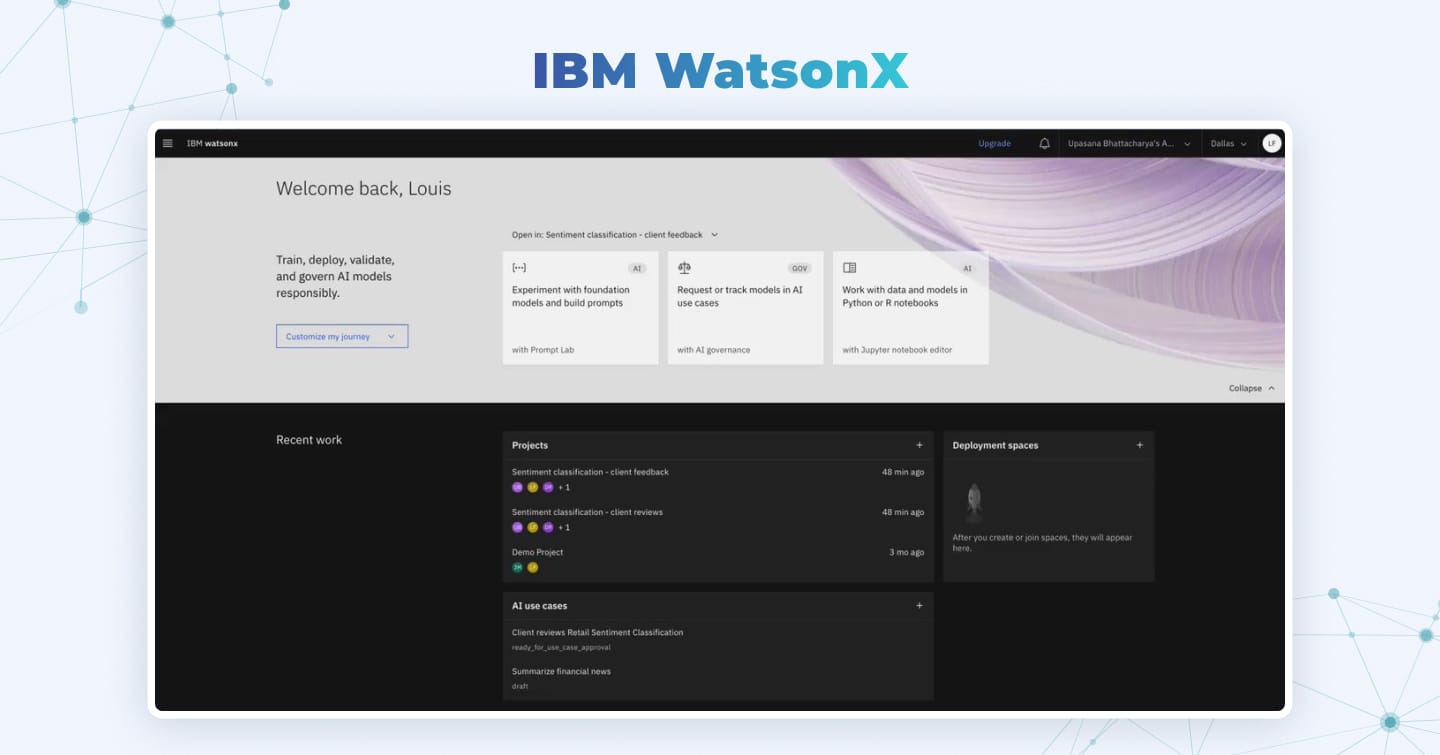
IBM WatsonX presents the latest evolution of AI capabilities from IBM, building on the legacy of the original Watson that gained fame in 2011. WatsonX is designed to make advanced AI more accessible and useful for developers, startups, and businesses across various industries.
Except for building ML models, WatsonX allows you to develop applications using generative AI models from IBM and open-source models from Hugging Face. These models can perform tasks such as generating text, classifying data, summarizing content, and extracting information from text inputs. This is particularly useful for creating applications that need to understand and interpet human language, like chatbots or virtual assistants.
The platform helps manage the AI lifecycle from start to finish. This includes data preparation, model training and validation and finally, product deployment. WatsonX ensures that AI models are reliable and effective, making it easier to integrate AI into your business operations.
Governance is another crucial aspect of WatsonX. It comes with tools for tracking the detailed history of AI models and evaluating their output. This helps creating AI systems that comply with regulatory standards and ethical guidelines, maintaining transparency and accountability.
Data preparation is made simpler with tools like Data Refinery, which helps clean, refine, and visualize data. This ensures that the data used in AI models is high quality and relevant, which is essential for accurate and effective AI applications.
| IBM WatsonX’s tools for AI development | |
| Watson Studio | A platform for developing and training AI models. |
| Watson Assistant | A tool for developing chatbots and virtual assistants. |
| Watson Discovery | Useful for extracting information from unstructured data. |
| Data Refinery | A tool for cleaning, refining, and visualizing data. |
| Visual Recognition | Useful for analyzing images. |
Want to know more about proven AI tools for your projects? Read our dedicated article “Best AI Tools for Developers: Expert Insights and Applications for All Work Types.”
There are a lot of other options on the market. For instance, Baidu Cloud AI Platform also offers capabilities such as computer vision, NLP, speech recognition, and knowledge graphs. One article wouldn’t be enough to cover all of them, but in case you want to learn how to choose the right one from this wide range of options, keep reading.
Key criteria for selecting an AI platform
To narrow down your choices for cloud AI platforms and services, you should consider the following factors.
Type of ML algorithms
Different types of ML algorithms are designed to handle various tasks, data types, and problem-solving approaches. For example, supervised learning algorithms are ideal for tasks where you have labeled data and need to make predictions based on it. In contrast, unsupervised learning algorithms are better for discovering hidden patterns in data without predefined labels. This is why, according to the AI Software of Choice 2022 report, 40.4% of respondents considered the type of ML algorithms the most important factor when selecting AI development software.
Time required for ML training
Prolonged training times can limit the usefulness of the supervised learning algorithms we've mentioned above. For instance, if you're using an algorithm to develop a customer recommendation system, the algorithm must first learn from a large dataset of customer interactions, which can be time-consuming.
In contrast, unsupervised learning algorithms can start identifying patterns and making predictions faster. However, they may have limitations, such as only being able to detect anomalies and often generating a high volume of alerts that require manual review. For example, an unsupervised learning algorithm used for fraud detection might quickly flag unusual transactions but would need human intervention to confirm if they are truly fraudulent.
Therefore, balancing the need for quick learning times with the accuracy and functionality required for your specific AI application is essential when choosing an AI cloud platform.
Integration with other systems
The platform should easily connect with your current infrastructure using APIs, automation tools, or outbound events. For instance, if you're implementing an AI-driven customer support system, it should effortlessly integrate with your existing CRM and ticketing systems to streamline operations.
Costs
Let’s say a company chooses a high-end AI platform with extensive features and top-tier support but fails to budget for the high ongoing costs. This might lead to financial strain, causing the company to cut back on other critical areas or even abandon the AI project altogether. On the other hand, a company that selects a cost-effective platform without sufficient capabilities might face inefficiencies, requiring additional investments in supplementary tools or custom solutions, ultimately costing more in the long run.
Support and documentation
Good support means having access to experts who can help you quickly resolve technical problems and optimize performance. This is especially important for complex AI systems, where clearly defined generative AI roles ensure that issues are identified and addressed efficiently by the right specialists with the necessary expertise.
Comprehensive documentation is equally valuable. It should provide clear instructions, examples, and best practices, helping your team understand and use the platform effectively. Proper documentation reduces the dependency on support.
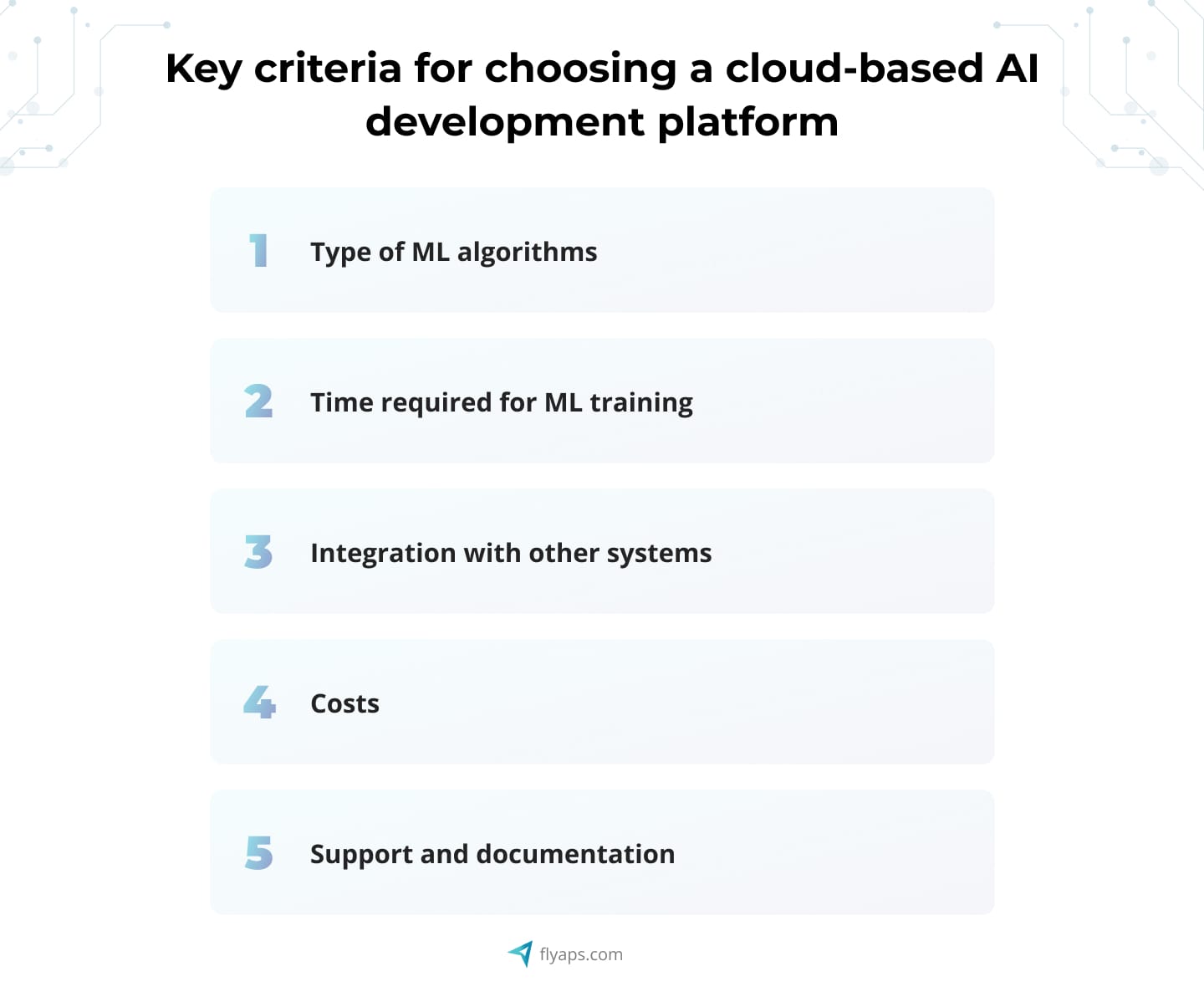
Considering building an AI project in the cloud? Flyaps can help you with it
With over 11 years of experience in the market, our AI developers has gained valuable insights into tech trends and best practices across various industries. This deep understanding helps us to use general cloud platforms and generative AI tech stack to create industry-specific AI solutions. Here's how we can assist you:
Cloud expertise
Our seasoned cloud engineers have the skills and experience to not only build and ensure cloud infrastructure for AI projects but also to move legacy desktop systems there. We handle the entire migration process, ensuring minimal disruption to your operations.
AI-focused solutions
We have a track record of delivering successful AI projects across various industries. What’s more, to save you time and money, we offer a range of pre-built tools that can be customized to meet your business’ unique needs.
Security and flexibility
We prioritize security in every aspect of our cloud and AI solutions. For industries with stringent security regulations, like telecom, we offer a hybrid cloud approach. This combines the best of both public and private clouds, giving you the flexibility to scale while ensuring your data remains secure.
Looking for a trusted partner to finally embrace AI through cloud platforms? We’re here to help. Just drop us a line!
Skip the endless hiring cycles. Scale your team fast with AI/ML, DevOps, and cloud specialists who delivered for Indeed, Orange, and Rakuten.
Scale your team

